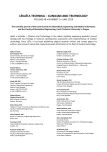Workflow for bioprinting of cell-ladem bioink
Autoři:
Sebastian Allig; Margot Mayer; Christiane Thieleman
Působiště autorů:
BioMEMS Lab, Faculty of Engineering, University of Applied Sciences Aschaffenburg, Germany
Vyšlo v časopise:
Lékař a technika - Clinician and Technology No. 2, 2018, 48, 46-51
Kategorie:
Original research
Souhrn
Applying technologies of additive manufacturing to the field of tissue engineering created a pioneering new approach to model complex cell systems artificially. Regarding its huge potential, bioprinting is still in its infancies and many questions are still unanswered. To address this issue, an extrusion-based bioprinting (EBB) process was used to deposit human embryonic kidney (HEK) cells in a defined pattern. It was shown that the bioprinted construct featured a high degree in viability reaching up to 77% 10 days after printing (DAP). This work displays a proof of principle for a controlled cell formation which shall later be applied to in vitro drug screening tests using various types of cells.
Keywords:
Extrusion-based bioprinting, bioink, tissue engineering, in vitro cell systems
Zdroje
- Clark, P., et al.: Growth cone guidance and neuron morphology on micropatterned laminin surfaces. Journal of cell science, 1993, 105(1): 202–212.
- Jungblut, M., et al.: Triangular neuronal networks on microelectrode arrays: an approach to improve the properties of low-density networks for extracellular recording. Biomedical microdevices, 2009, 11(6): 1269–1278.
- Ruiz, S. A., et al.: Microcontact printing: A tool to pattern. Soft Matter, 2007, 3(2): 168–177.
- Pan, L., et al.: An in vitro method to manipulate the direction and functional strength between neural populations. Frontiers in neural circuits, 2015, 9(32).
- Krumpholz, K., et al.: A microfluidic device for selective positioning of invertebrate neurons. 9th int. meeting on substrate-integrated microelectrode arrays, 2014.
- Jones, N.: Science in three dimensions: the print revolution. Nature, 2012, 487(7405): 22–23.
- Ozbolat, I. T.: 3D Bioprinting: Fundamentals, Principles and Applications. 1nd ed. Academic Press, 2017.
- Husain, S. R., et al.: Current status and challenges of three-dimensional modeling and printing of tissues and organs. Tissue engineering: part A, 2017, 23(11–12).
- Puelacher, W. C., et al.: Tissue-engineered growth of cartilage: the effect of varying the concentration of chondrocytes seeded onto synthetic polymer matrices. International journal of oral and maxillofacial surgery, 1994, 23(1): 49–53.
- Rowley, J. A.: Alginate hydrogels as synthetic extracellular matrix materials. Biomaterials, 1999, 20(1): 45–53.
- Martinez, H., et al.: 3D bioprinting of human chondrocyte-laden nanocellulose hydrogels for patient-specific auricular cartilage regeneration. Bioprinting, 2016, 1(2): 22–35.
- Möller, T., et al.: In vivo chondrogenesis in 3d bioprinted human cell-laden hydrogel constructs. Plastic and reconstructive surgery global open, 2017, 5(2): 1227.
- Prowse, A. B. J., et al.: Stem cell integrins: implications for ex-vivo culture and cellular therapies. Stem cell research, 2011, 6(1): 1–12.
- Grant, G. T., et al.: Biological interactions between poly-saccharides and divalent cations: The egg-box model. FEBS Letters, 1973, 32(1): 195–198.
- Ahmed, E. M., et al.: Hydrogel: preparation, characterization, and applications: a review. Journal of advanced research, 2015, 6(2): 105–121.
- Mayer, M., et al.: Electrophysiological investigation of human embryonic stem cell derived neurospheres using a novel spike detection algorithm. Biosensors and bioelectronics, 2018, 100: 462-468.
- Suntornnond, R., et al.: A mathematical model on the resolution of extrusion bioprinting for the development of new bioinks. Materials, 2016, 9(9): 756.
- Gibson, I., et al.: Additive manufacturing technologies: 3D printing, rapid prototyping and direct digital manufacturing. Springer, New York, 2015, 2nd edition.
- He, Y., et al.: Research on the printability of hydrogels in 3D bioprinting. Scientific Reports, 2016, 6:29977.
- Blaeser, A., et al.: Controlling shear stress in 3D bioprinting is a key factor to balance printing resolution and stem cell integrity. Advanced healthcare materials, 2016, 5(3): 326–333.
Štítky
BiomedicínaČlánek vyšel v časopise
Lékař a technika

2018 Číslo 2
Nejčtenější v tomto čísle
- Application of sibgle wireless holter to simultaneous EMG, MMG and eim measurement of human muscles activity
- Response by an automated inspired oxygen control system to hypoxemic episodes: assessment of damping
- Workflow for bioprinting of cell-ladem bioink
- Machine learning using speech utterances for parkinson disease detection
